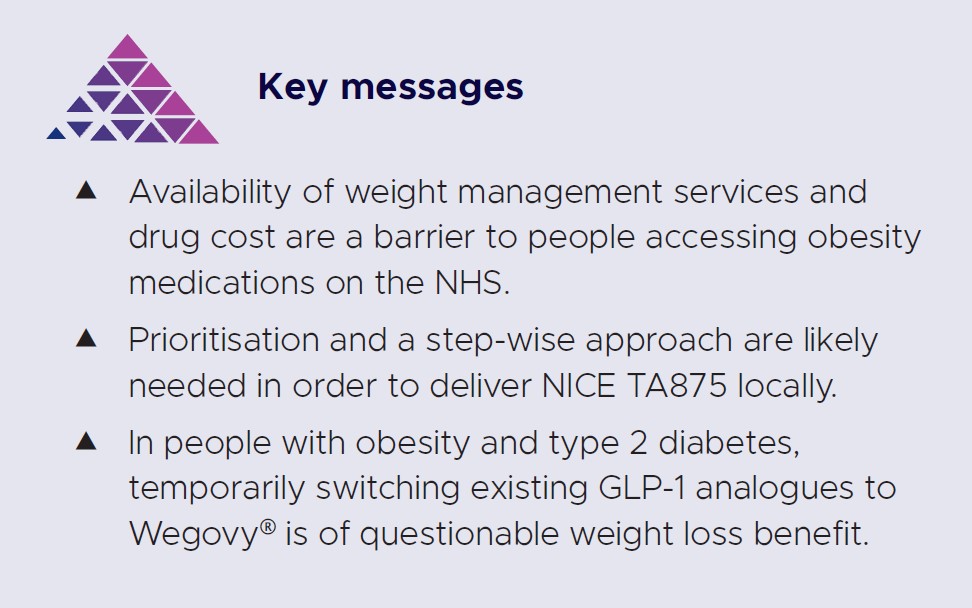A critique of semaglutide (Wegovy®) for obesity management NICE technology appraisal TA875
HASSAN KAHAL,1,2 CHRIS WALTON3
1 Bristol Weight Management and Bariatric Service, Southmead Hospital, North Bristol NHS Trust, Bristol, UK
2 Department of Diabetes and Endocrinology, Southmead Hospital, North Bristol NHS Trust, Bristol, UK
3 Department of Diabetes and Endocrinology, Hull University Teaching Hospitals NHS Trust, Hull, UK
Address for correspondence: Dr Hassan Kahal
Consultant in Diabetes, Endocrinology and Obesity Medicine, Department of Diabetes and Endocrinology, Southmead Hospital, Bristol BS10 5NB, UK.
E-mail: hassan.kahal1@nhs.net
Abstract
Wegovy®, semaglutide 2.4 mg, is a glucagon-like peptide-1 analogue that has been approved by the National Institute for Health and Care Excellence (NICE) for the treatment of adults with obesity in the National Health Service (NHS). In this review, we provide a reflection on NICE TA875 and its implementation in the NHS.
Br J Diabetes 2024;24(1):13-15
https://doi.org/10.15277/bjd.2024.439
Key words: obesity, Wegovy®, semaglutide, NICE TA875
Introduction
In March 2023 the National Institute for Health and Care Excellence (NICE) published its technology appraisal of semaglutide (Wegovy®) for managing overweight and obesity in adults, TA875.1 This is the second drug that NICE has approved for obesity management from the class of glucagon- like peptide-1 (GLP-1) analogues. In this review, we provide a reflection on NICE TA875 from a national health service (NHS) service provider point of view.
The clinical efficacy for Wegovy® (semaglutide 2.4 mg once a week) as a weight loss medication was examined in the STEP clinical trials.2-8 Semaglutide 2.4 mg resulted in 14.9% weight loss at 68 weeks of treatment (12.4% vs. placebo) in people with overweight or obesity without type 2 diabetes (T2DM) in the STEP 1 trial;2 and 9.6% weight loss at 68 weeks of treatment (6.2% vs. placebo) in people with overweight or obesity and T2DM in the STEP 2 trial.3
NICE TA875 recommended semaglutide 2.4 mg as an option for weight management, including weight loss and weight maintenance, alongside a reduced-calorie diet and increased physical activity in adults, only if:
-
It is used for a maximum of two years, and within a specialist weight management service providing multidisciplinary management of overweight or obesity (including but not limited to tiers 3 and 4), and
-
They have at least one weight-related co-morbidity and:
-
a body mass index (BMI) of at least 35.0 kg/m2, or a BMI of 30.0 kg/m2 to 34.9 kg/m2 and meet the criteria for referral to specialist weight management services.
-
Lower BMI thresholds (usually reduced by 2.5 kg/m2) are to be used for people from South Asian, Chinese, other Asian, Middle Eastern, Black African or African-Caribbean family backgrounds.
-
Consider stopping semaglutide if less than 5% of the initial weight has been lost after six months of treatment.

Challenges to implementation
The NICE technology appraisal provides an important step in enabling people with obesity to access a potent treatment to help them lose weight and improve their health and wellbeing on the NHS. However, implementing NICE TA875 in the NHS is likely to face multiple challenges: here, we include a few:
-
Around 7-10% of the adult population living in England have a BMI 35 kg/m2 and above;9 the majority of them would be eligible to receive Wegovy® on the NHS. While not all eligible individuals would want medical therapy for obesity, it is likely that the number of people desiring, and who would benefit from, such a treatment, far outweighs the capacity of current specialist multidisciplinary weight management services. Subsequently, there is a need to expand current specialist weight management services and to increase their availability in primary and secondary care. Commissioners may also want to take a stepwise approach in implementing NICE TA875, beginning by focusing on people who may benefit most from the treatment. These include, for example, people with prior cardiovascular disease who are 45 years of age or older,10 people with heart failure and preserved ejection fraction,11 and people without T2DM (see comment 6 below).
-
It is not clear in NICE TA875 what defines a ‘’weight-related co-morbidity’’. The STEP trials included people with BMI of 30 kg/m2 regardless of complications; or BMI >27 kg/m2 and T2DM or at least one other complication, including cardiovascular disease, dyslipidaemia, hypertension and obstructive sleep apnoea. However, obesity-related co- morbidities are much wider than those selected for inclusion in the STEP trials. They include, for example, osteoarthritis, depression, polycystic ovary syndrome (PCOS), idiopathic intracranial hypertension and metabolic-associated fatty liver disease (MAFLD). We believe, that in the absence of a clear definition of a ‘’weight-related co-morbidity’’ from NICE, the wider definition should be used based on clinical judgement.
-
The group with BMI 30-34.9 kg/m2 raises a significant challenge to clinical services. NICE included this group based on the assumption that referrals are made to specialist weight management services (tier 3) only rarely from this cohort. Subsequently, NICE predicted that this population would represent a very small number of people eligible for semaglutide. However, we expect a significant increase in referrals to obesity services from this population following the NICE appraisal. This is likely to be driven by individuals’ justified desire to access effective medical therapies for obesity, and by the strong advertisement campaign of the drug in the media. We expect that each region in England will need to make some difficult decisions around prioritisation and about their ability to support this population, at least at the initial stage.
-
The 5% weight loss target at six months is proposed to differentiate between responders and non-responders to the treatment. This is to ensure that treatment is directed towards those who will benefit most from it. However, how that would affect people with T2DM who are already on GLP-1 analogue therapy is not clear. Those individuals are likely to have lost some weight already through GLP-1 analogue therapy. While a switch to Wegovy® is likely to provide a top-up of their GLP-1 dose and result in more weight loss, they will be disadvantaged in attempting to reach the same weight loss target at six months as GLP-1 analogue-naïve individuals.
-
Similar to the position with Saxenda® (liraglutide 3.0 mg), NICE only recommended treatment with semaglutide for obesity management for a maximum of two years on the NHS. Data from the STEP 4 and STEP 1 extension trials suggest that people with obesity who stop semaglutide regain half to two-thirds of the initial weight loss at around one year off treatment.5,12 Many individuals who respond well to treatment will be disappointed if it is then discontinued. Unless obesity treatment is accepted to be life-long, similar to other chronic diseases, this is likely to result in repeated referrals to obesity services for the same individuals. Thus, each commissioning body will need to decide whether people could be referred for another course of treatment and, if so, after how long.
-
The benefits of temporarily switching other GLP-1 analogue therapies to Wegovy® in people with T2DM, in terms of kilograms in weight lost, will also be questionable; particularly with the arrival of newer medications for T2DM that project significant weight loss.13
-
Despite the NHS price discount, the cost of the drug, considering the large number of potential users, is likely to represent a huge burden and a challenge to many commissioners in a climate of restricted resources. Subsequently, there is a need to increase funding for the NHS in general and obesity services in particular. There is also a call to pharmaceutical companies to review their profit margins to enable more people to access new treatments for obesity.
Conclusion
In summary, while semaglutide 2.4mg (Wegovy®) delivery is likely to carry challenges in clinical practice in the NHS, NICE TA875 is a welcome step in recognising obesity as a disease and improving access to medical therapy for people with obesity.

© 2024. This work is openly licensed via CC BY 4.0.
This license enables reusers to distribute, remix, adapt, and build upon the material in any medium or format, so long as attribution is given to the creator. The license allows for commercial use. CC BY includes the following elements: BY – credit must be given to the creator.
Copyright ownership The author(s) retain copyright.
Conflict of interest The authors have no conflicts of interest to declare in relation to this work.
Funding None.
References
-
https://www.nice.org.uk/guidance/ta875; accessed on 5/10/2023
-
Wilding JPH, Batterham RL, Calanna S, et al.; the STEP 1 Study Group. Once-weekly semaglutide in adults with overweight or obesity. N Engl J Med 2021;384(11):989-1002. https://doi.org/10.1056/NEJMoa2032183
-
Davies M, Færch L, Jeppesen OK, et al.; the STEP 2 Study Group. Semaglutide 2·4 mg once a week in adults with overweight or obesity, and type 2 diabetes (STEP 2): a randomised, double-blind, double-dummy, placebo-controlled, phase 3 trial. Lancet 2021;397(10278):971-84. https://doi.org/10.1016/S0140-6736(21)00213-0
-
Wadden TA, Bailey TS, Billings LK, et al.; the STEP 3 Investigators. Effect of subcutaneous semaglutide vs placebo as an adjunct to intensive behavioral therapy on body weight in adults with overweight or obesity: the STEP 3 randomized clinical trial. JAMA 2021;325(14):1403-13. https://doi.org/10.1001/jama.2021.1831
-
Rubino D, Abrahamsson N, Davies M, et al.; the STEP 4 Investigators. Effect of continued weekly subcutaneous semaglutide vs placebo on weight loss maintenance in adults with overweight or obesity: the STEP 4 randomized clinical trial. JAMA 2021;325(14):1–12. https://doi.org/10.1001/jama.2021.3224
-
Garvey WT, Batterham RL, Bhatta M, et al.; the STEP 5 Study Group. Two-year effects of semaglutide in adults with overweight or obesity: the STEP 5 trial. Nat Med 2022;28(10):2083-91. https://doi.org/10.1038/s41591-022-02026-4
-
Kadowaki T, Isendahl J, Khalid U, et al.; STEP 6 investigators. Semaglutide once a week in adults with overweight or obesity, with or without type 2 diabetes in an east Asian population (STEP 6): a randomised, double-blind, double-dummy, placebo-controlled, phase 3a trial. Lancet Diabetes Endocrinol 2022;10(3):193-206. https://doi.org/10.1016/S2213-8587(22)00008-0.
-
Rubino DM, Greenway FL, Khalid U, et al.; the STEP 8 Investigators. Effect of weekly subcutaneous semaglutide vs daily liraglutide on body weight in adults with overweight or obesity without diabetes. The STEP 8 Randomized Clinical Trial. JAMA 2022;327(2):138-150. https://doi.org/10.1001/jama.2021.23619.
-
https://digital.nhs.uk/data-and-information/publications/statistical/health-survey-for-england/2019/health-survey-for-england-2019-data-tables; accessed 05/10/2023.
-
Lincoff AM, Brown-Frandsen K, Colhoun HM, et al.; for the SELECT Trial Investigators. Semaglutide and cardiovascular outcomes in obesity without diabetes. N Engl J Med 2023;389:2221-32. https://doi.org/10.1056/NEJMoa2307563.
-
Kosiborod MN, Abildstrøm SZ, Borlaug BA, et al.; the STEP-HFpEF Trial Committees and Investigators. Semaglutide in patients with heart failure with preserved ejection fraction and obesity. N Engl J Med 2023;389(12):1069-84. https://doi.org/10.1056/NEJMoa2306963.
-
Wilding JPH, Batterham RL, Davies M, et al.; the STEP 1 Study Group. Weight regain and cardiometabolic effects after withdrawal of semaglutide: the STEP 1 trial extension. Diabetes Obes Metab 2022;24:1553–64. https://doi.org/10.1111/dom.14725.
-
https://www.nice.org.uk/guidance/TA924; accessed on 07/06/2024